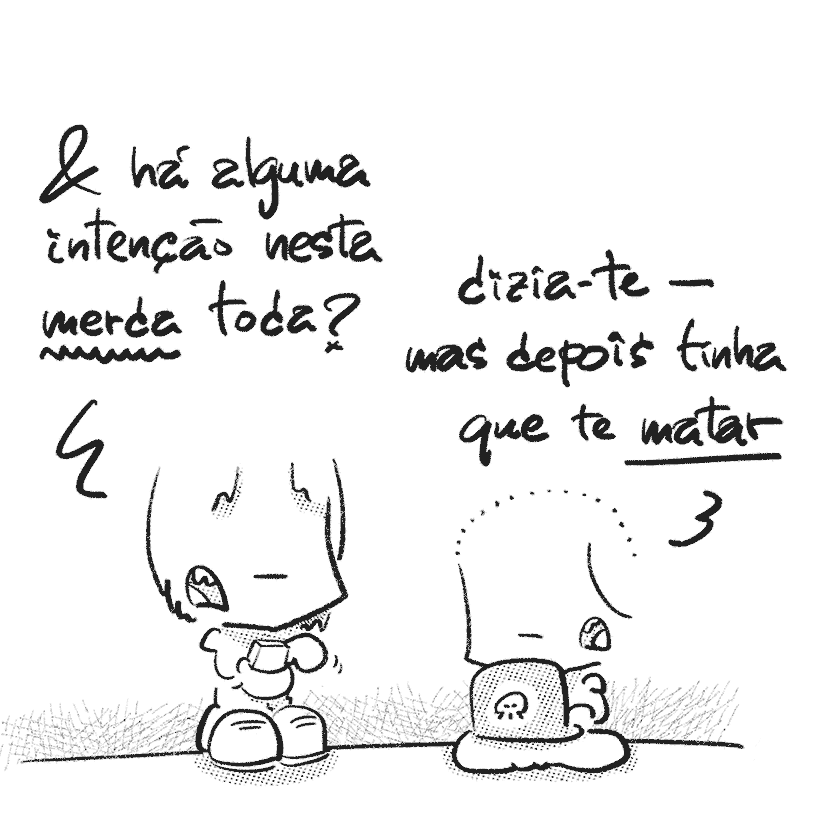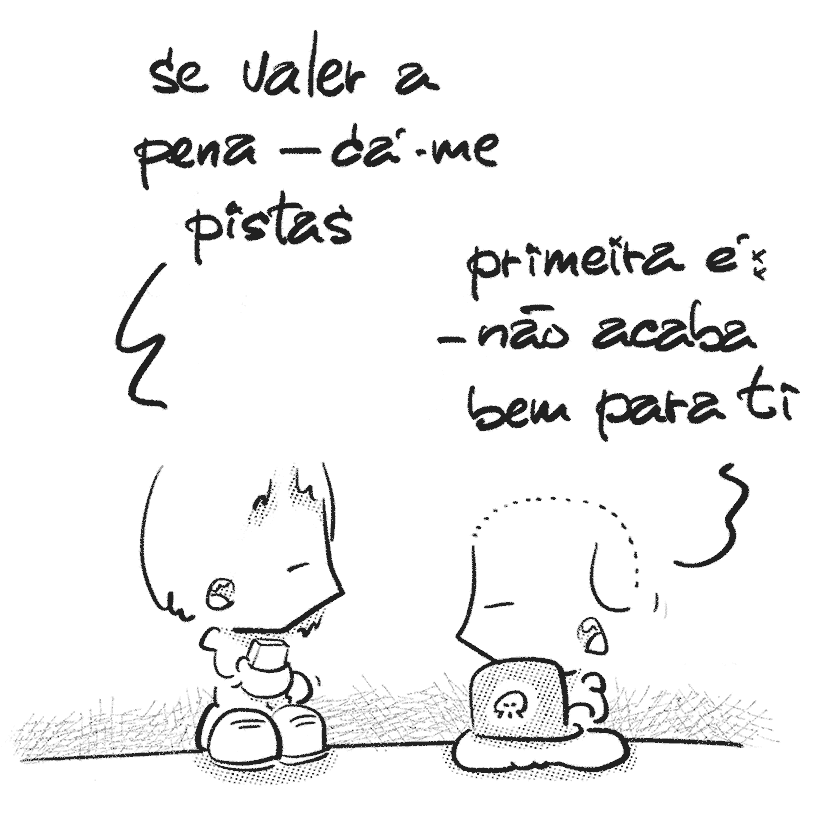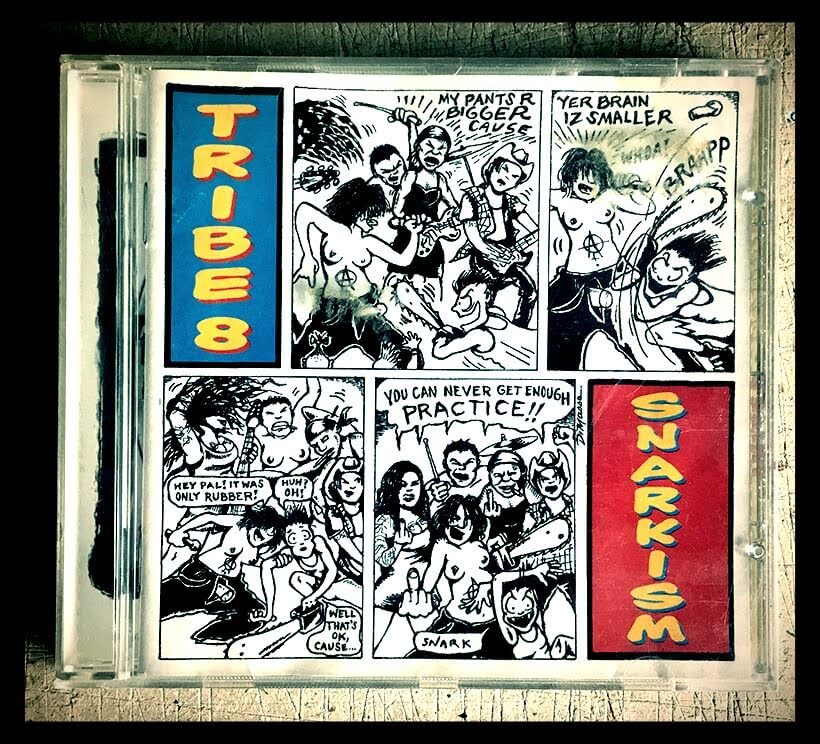três intenções ao lado
Trust in an artist’s ability to meet their intentions is also sometimes earned through giving the reader small moments of recognition (...), puzzles to be put together (...) that pleasantly resolves itself into understanding.
in "Exploring The Concept of Intentionality in Art Comics – Kimball Anderson" 5 fev 2020
Escolhemos fechar a semana que recordámos que Farrajota ignorou zines no seu relatório in com outros dependes. Como descodificar intenções numa obra que parece random? O autor do texto para hoje aponta três requisitos no que "isn’t meant to be a comprehensive list of Art Comics tricks": 1) obviamente, que o autor tenha uma, 2) essa tem que ser executada obedecendo a uma lógica coerente 3) os dois pontos anteriores serão inválidos se a sua audiência não partilha dela. Juicy stuff que retalhamos em acelerado, no final do qual propomos que não esgota as possibilidades.
When a piece of art looks like lines and shapes thrown against a page in a frenetic rush, how do you know it has meaning rather than just being random visual noise? When a comic is built out of abstract shapes and loosely connected words, how do you trust that it has a purpose behind it? In comics, having a slick and well-designed visual style is a well-worn method to earn this trust. It feels like the artist’s intention is fully realized, and everything they are doing is what they meant to do. But in Art Comics, it’s a common practice to embrace messiness and ambiguity, and do away with the style of clean lines and clear shapes. So how do these artists maintain trust and show that there is intentionality to their work?
- 1) Much of how we appreciate narrative media is based on how much we trust that the person who has made it knows what they are doing.
- 2) Intentionality isn’t just a matter of what the intent seems to be, but also how well that intent is executed. Something doesn’t look “intentional” just because it looks like there’s intent behind it, it looks intentional if it seems that the artist had something in mind when they created the piece and followed through successfully on it.
- 3) Intentionality isn’t as simple as what the artist intends, it’s about what the audience thinks the artist intends. It’s not about the actual intention, it’s about the intention that a work implies.
So when the reader searches and finds something that makes sense, or is meaningful, the artist has proven to them that there is a competent hand guiding the reading experience, that the artist is skilled enough to meet the intention of the piece.
in "Exploring The Concept of Intentionality in Art Comics – Kimball Anderson" 5 fev 2020
O absurdo da hipótese: a peça é independente do artista. A insuficiência da hipótese: a sua validação dependente de terceiros, estranhamos a necessidade. Já o afirmamos diversas vezes, "a BD tem que ser lida", mas reservem uma distância entre a interpretação que lhe fazem e sua explicação. À intencionalidade de comunicação de ambas as partes concordamos que o grau de sucesso da dita se deve à eficiência da execução, e temos feito o caso vezes infinitas aos comics como mass media. Mas comunicação é apenas uma de muitas intencionalidades possíveis. Ocorre-nos outra mais próxima de casa: expressão como imperativo sem pretensões a que os ceús nos oiçam ou respondam. (*) "Artists will create regardless of whether anyone observes, records, disseminates, applauds, tuts or hisses", daqui! Toda uma outra escola de pensamento que tendem a confundir na aparência minus a atitude aos Art Comics, Poetry Comics, Experimental Comics, Abstract Comics: o punk. Descontextualizamos — intended! — para conclusões:
If someone intentionally tried to tell a traditional story but with a unique structure to it, we might say it has “structure problems” because it would be interpreted as trying to follow a more well-trod structure and failing [ MAS ] while many Art Comics pull on art world influences, there is also a strong contingent within the genre that developed from the punk scene and DIY zine culture. Punk is very much about the democratization of art, about breaking down authority and gatekeepers, so [it] doesn’t need to be proven to be competent or in control in the same way as other styles.
in "Exploring The Concept of Intentionality in Art Comics – Kimball Anderson" 5 fev 2020
Nunca é demais recordar, o punk não é só estilo, e os que não têm intenções ao espectro arsty da BD estão isentos de ditas regras. Duvidamos até que vão ao mesmo jogo, têm que lhes encontrar outros tricks.


 "simple minds know two kinds and I'm number 3"
"simple minds know two kinds and I'm number 3"